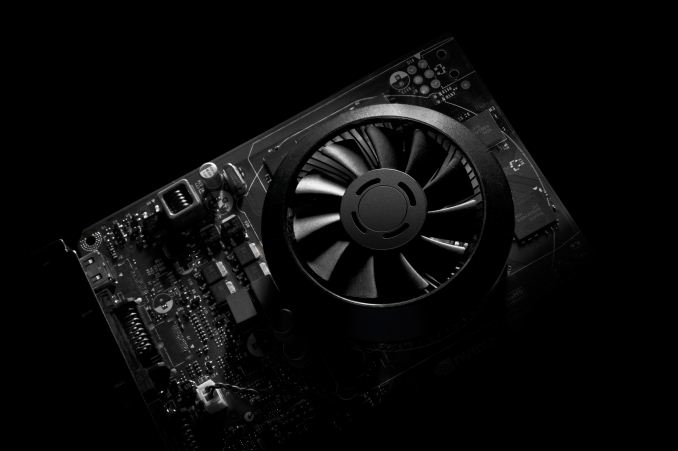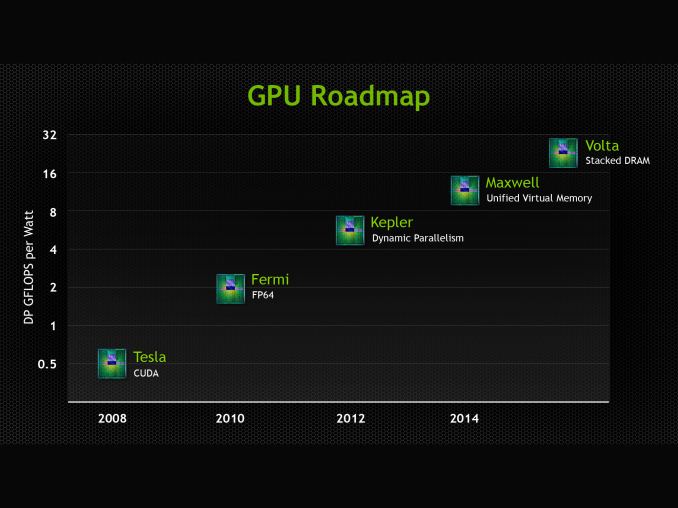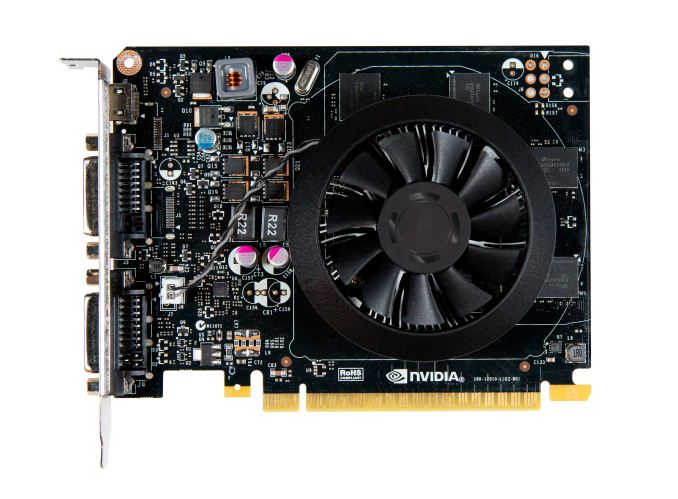The NVIDIA GeForce GTX 750 Ti and GTX 750 Review: Maxwell Makes Its Move
by Ryan Smith & Ganesh T S on February 18, 2014 9:00 AM EST
As the GPU company who’s arguably more transparent about their long-term product plans, NVIDIA still manages to surprise us time and time again. Case in point, we have known since 2012 that NVIDIA’s follow-up architecture to Kepler would be Maxwell, but it’s only more recently that we’ve begun to understand the complete significance of Maxwell to the company’s plans. Each and every generation of GPUs brings with it an important mix of improvements, new features, and enhanced performance; but fundamental shifts are fewer and far between. So when we found out Maxwell would be one of those fundamental shifts, it changed our perspective and expectations significantly.
What is that fundamental shift? As we found out back at NVIDIA’s CES 2014 press conference, Maxwell is the first NVIDIA GPU that started out as a “mobile first” design, marking a significant change in NVIDIA’s product design philosophy. The days of designing a flagship GPU and scaling down already came to an end with Kepler, when NVIDIA designed GK104 before GK110. But NVIDIA still designed a desktop GPU first, with mobile and SoC-class designs following. However beginning with Maxwell that entire philosophy has come to an end, and as NVIDIA has chosen to embrace power efficiency and mobile-friendly designs as the foundation of their GPU architectures, this has led to them going mobile first on Maxwell. With Maxwell NVIDIA has made the complete transition from top to bottom, and are now designing GPUs bottom-up instead of top-down.
Nevertheless, a mobile first design is not the same as a mobile first build strategy. NVIDIA has yet to ship a Kepler based SoC, let alone putting a Maxwell based SoC on their roadmaps. At least for the foreseeable future discrete GPUs are going to remain as the first products on any new architecture. So while the underlying architecture may be more mobile-friendly than what we’ve seen in the past, what hasn’t changed is that NVIDIA is still getting the ball rolling for a new architecture with relatively big and powerful GPUs.
This brings us to the present, and the world of desktop video cards. Just less than 2 years since the launch of the first Kepler part, the GK104 based GeForce GTX 680, NVIDIA is back and ready to launch their next generation of GPUs as based on the Maxwell architecture.
No two GPU launches are alike – Maxwell’s launch won’t be any more like Kepler’s than Kepler was Fermi’s – but the launch of Maxwell is going to be an even greater shift than usual. Maxwell’s mobile-first design aside, Maxwell also comes at a time of stagnation on the manufacturing side of the equation. Traditionally we’d see a new manufacturing node ready from TSMC to align with the new architecture, but just as with the situation faced by AMD in the launch of their GCN 1.1 based Hawaii GPUs, NVIDIA will be making do on the 28nm node for Maxwell’s launch. The lack of a new node means that NVIDIA would either have to wait until the next node is ready, or launch on the existing node, and in the case of Maxwell NVIDIA has opted for the latter.
As a consequence of staying on 28nm the optimal strategy for releasing GPUs has changed for NVIDIA. From a performance perspective the biggest improvements still come from the node shrink and the resulting increase in transistor density and reduced power consumption. But there is still room for maneuvering within the 28nm node and to improve power and density within a design without changing the node itself. Maxwell in turn is just such a design, further optimizing the efficiency of NVIDIA’s designs within the confines of the 28nm node.
With the Maxwell architecture in hand and its 28nm optimizations in place, the final piece of the puzzle is deciding where to launch first. Thanks to the embarrassingly parallel nature of graphics and 3D rendering, at every tier of GPU – from SoC to Tesla – GPUs are fundamentally power limited. Their performance is constrained by the amount of power needed to achieve a given level of performance, whether it’s limiting clockspeed ramp-ups or just building out a wider GPU with more transistors to flip. But this is especially true in the world of SoCs and mobile discrete GPUs, where battery capacity and space limitations put a very hard cap on power consumption.
As a result, not unlike the mobile first strategy NVIDIA used in designing the architecture, when it comes to building their first Maxwell GPU NVIDIA is starting from the bottom. The bulk of NVIDIA’s GPU shipments have been smaller, cheaper, and less power hungry chips like GK107, which for the last two years has formed the backbone of NVIDIA’s mobile offerings, NVIDIA’s cloud server offerings, and of course NVIDIA’s mainstream desktop offerings. So when it came time to roll out Maxwell and its highly optimized 28nm design, there was no better and more effective place for NVIDIA to start than with the successor to GK107: the Maxwell based GM107.
Over the coming months we’ll see GM107 in a number of different products. Its destiny in the mobile space is all but set in stone as the successor to the highly successful GK107, and NVIDIA’s GRID products practically beg for greater efficiency. But for today we’ll be starting on the desktop with the launch of NVIDIA’s latest desktop video cards: GeForce GTX 750 Ti and GeForce GTX 750.













177 Comments
View All Comments
MrSpadge - Tuesday, February 18, 2014 - link
To be fair GTX650Ti Boost consumes ~100 W in the real world. Still a huge improvement!NikosD - Tuesday, February 18, 2014 - link
Hello.I have a few questions regarding HTPC and video decoding.
Can we say that we a new video processor from Nvidia, a new name like VP6 or more like a VP5.x ?
How Nvidia is calling the new video decoder ?
Why don't you add a 4K60 fps clip in order to test soon to be released HDMI 2.0 output ?
If you run a benchmark using DXVA Checker between VP5 and VP6 (?) how much faster is VP6 in H.264 1080p, 4K clips ?
Thanks!
Ryan Smith - Thursday, February 20, 2014 - link
NVIDIA doesn't have a name for it; at least not one they're sharing with us.NikosD - Thursday, February 20, 2014 - link
Thanks.Is it possible to try a 4K60fps with Maxwell ?
I wonder if it can decode it in realtime...
Flunk - Tuesday, February 18, 2014 - link
I think these will be a lot more exciting in laptops. Even if they're no where near Nvidia's claimed 2x Kepler efficiency per watt. On the desktop it's not really that big a deal. The top-end chip will probably be ~40% faster than the 780TI but that will be a while.dylan522p - Tuesday, February 18, 2014 - link
the 880 will be much more powerful than the 780ti. More than 40% even. They could literally die shrink and throw a few more SMX's and the 40% would be achieved. I would imagine either they are gonna have a HUGE jump (80% +) or they are gonna do what they did with Kepler and release a 200W Sku that is about 50% faster and when 20nm yields are good enough have the 900 series come with 250W Skus.Kevin G - Tuesday, February 18, 2014 - link
Very impressive performance for its power consumption. I can see an underclocked version of this card coming with a passive cooler for HTPC solutions. Perhaps that'd be a hypothetical GT740? I'm surprised that nVidia hasn't launched a mobile version of this chip. It seems like it'd be ideal for midrange laptops that still have discrete graphics.I suspect that the extra overclocking headroom is in reserve for a potential rebrand to a GTX 800 series product. (Though a straight die shrink of this design to 20 nm would provide even more headroom for a GTX 800/900 card.) nVidia could have held back to keep it below the more expensive GTX 660.
Though ultimately I'm left wanting the bigger GM100 and GM104 chips. We're going to have to wait until 20 nm is ready but considering the jump Maxwell has provided in the low end of the market, I'm eager to see what it can do in the high end.
DanNeely - Tuesday, February 18, 2014 - link
ASUS has a 65W TDP GT 640 with a big 2 slot passive heat sink (GT640-DCSL-2GD3); with the 750 Ti only hitting 60W a passive version of it should be possible at near stock performance. I suspect the 740 will be a farther cut down 3 SMM model which might allow a single slot passive design.PhoenixEnigma - Tuesday, February 18, 2014 - link
Passive cooling was my first thought as well - I've been looking for something to replace the 6770 in my HTPC with, and I wanted something both faster and passively cooled. There are already passive 7750s on the market, and the numbers in Bench put the 750Ti at about 9W more than then 7750 under real world load, so a vanilla 750 with a passive cooler should be entirely possible. Even a 750Ti might be doable, but that could be pushing things a little far.evilspoons - Tuesday, February 18, 2014 - link
I need a new half-height HTPC card, my 2.5 year old Asus Radeon 6570 bit the dust last month (sparkly picture, one particular shade of grey turned random colours). If they can work out the kinks in this thing and underclock it a bit, it sounds like a good candidate.It feels like it's been a long time since anything new showed up in the half-height video card game.